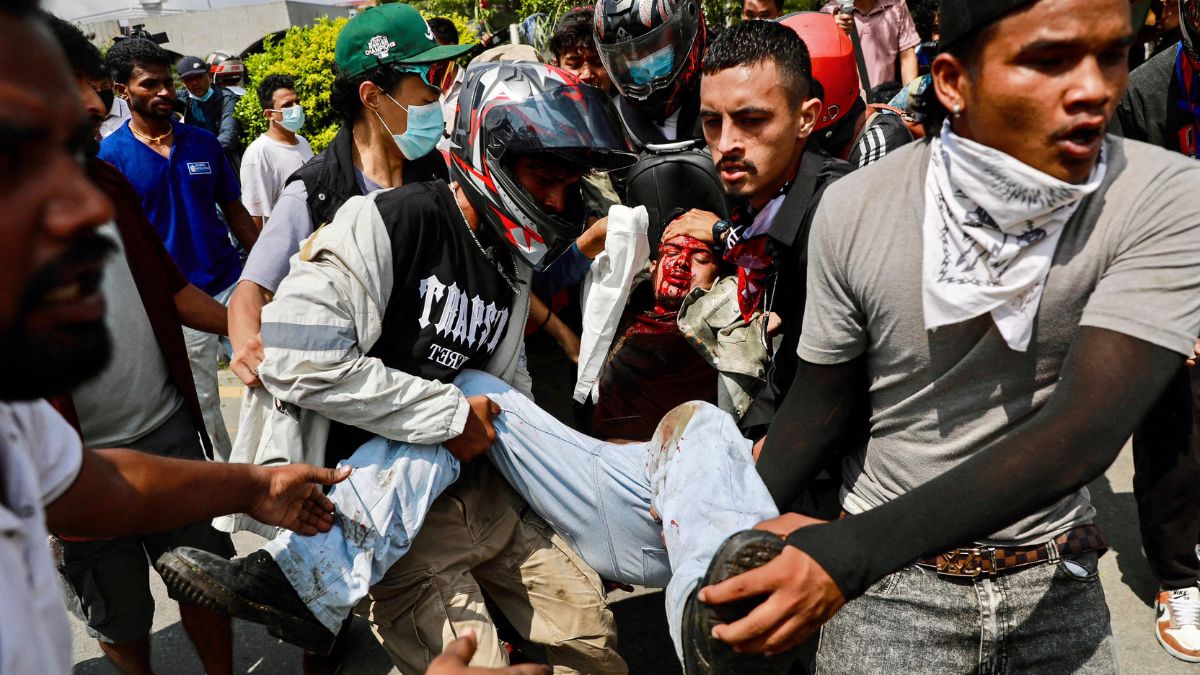At least 19 persons have been killed in Nepal and more than 340 injured as police opened fire at youth protesting against government’s corruption and ban on social media.
Days after Nepal banned 26 social media platforms, such as Facebook and Instagram, several thousands of youngsters on Monday took to streets in several cities, including the capital Kathmandu, and their protests turned bloody as the police cracked down with tear gas, water cannon, and gunfire.
Of the 19 dead, 17 were killed in Kathmandu and two were killed in the Sunsari district in eastern Nepal’s Koshi province, according to The Kathmandu Post.
At least 347 people have been injured across the country, with more than 250 in Kathmandu alone.
The toll is expected to rise as details about the dead and injured come to light.
In Kathmandu, The Post reported that eight people died at the National Trauma Centre, three at Everest Hospital, three at Civil Hospital, two at Kathmandu Medical College (KMC), and one at Tribhuvan Teaching Hospital. The newspaper reported that the police shot dead two people in Itahari area of Sunsari district.
Across the country, at least 347 injured protesters have been admitted to hospitals, with dozens of them in critical condition, according to The Post.
The Civil Hospital is treating 100, Trauma Centre 59, Everest 102, KMC 37, Bir Hospital six, Patan Hospital four, Tribhuvan Teaching 18, Norvic three, BP Koirala Institute of Health Sciences two, Gandaki Medical College one, Birat Medical College four, and Damak Hospital seven, as per The Post.
Impact Shorts
More ShortsEverest Hospital’s Anil Adhikari told The Post four patients were serious condition and Dr Dipendra Pandey at Trauma Centre said 10 were critical. They said protesters were hit with bullet wounds in the head and chest.
Other than Kathmandu and Sunsari, protests were held in Pokhara in western Nepal, Hetauda in central Nepal, Biratnagar in eastern Koshi province, Janakpur in eastern Madhesh province along the border with India, and Nepalgunj in southern Lumbini province, as per The Post.
Youth lead charge against Nepali govt
Several thousands of Nepali youngsters took to streets in Kathmandu on Monday in protest against Prime Minister KP Sharma Oli’s government. They carried placards with slogans such as “Shut down corruption and not social media”, “Unban social media”, and “Youths against corruption”, as per Reuters.
As thousands of protestors, many of them in school or college uniforms, marched towards the parliament, the police set up barricades to stop them.
However, as protesters breached the restricted zone and entered the parliament premises, the police responded with water cannon, tear gas, and live ammunition, according to The Post.
#WATCH | Nepal | Protestors vandalise the Parliament gate as the protest turned violent in Kathmandu, as people staged a massive protest against the ban on Facebook, Instagram, WhatsApp and other social media sites, leading to clashes between police and protesters pic.twitter.com/dkh9Mg7BGc
— ANI (@ANI) September 8, 2025
The authorities have imposed a curfew in Kathmandu amid protests.
“We have imposed a curfew which will remain in force until 10 p.m. local time (1615 GMT) to bring the situation under control after protesters began to turn violent,” Muktiram Rijal, a spokesperson for the Kathmandu district office, told Reuters.
Social media ban brings mass anger to fore
The immediate trigger of youth-led protests, being dubbed the ‘Gen Z protest’, is the government’s move to ban 26 social media platforms, including Facebook, Instagram, and X, for not complying with the government’s policy. The AFP has reported that many such platforms have not been accessible in the country since Friday and have affected millions of users who rely on these platforms to run businesses, read news, and stay connected with friends and family.
However, the ban merely brought public’s anger against the government and politicians to the fore that had been there for a long time.
“We were triggered by the social media ban but that is not the only reason we are gathered here. We are protesting against corruption that has been institutionalised in Nepal,” Yujan Rajbhandari, a 24-year-old student, told AFP.
Another student, Ikshama Tumrok, 20, said she was protesting against the “authoritarian attitude” of the government.
“We want to see change. Others have endured this, but it has to end with our generation,” Tumrok told AFP.
Nepal has long had political instability where weak governments have ruled the country since the abolition of the monarchy in 2008. No government has completed its five-year term as coalitions often fail to hold and infighting leads to the collapse of the government. The public perception that the corruption is rampant has increased over the years.
“There have been movements abroad against corruption and they (the government) are afraid that might happen here as well,” protester Bhumika Bharati told AFP.


)

)
)
)
)
)
)
)
)



